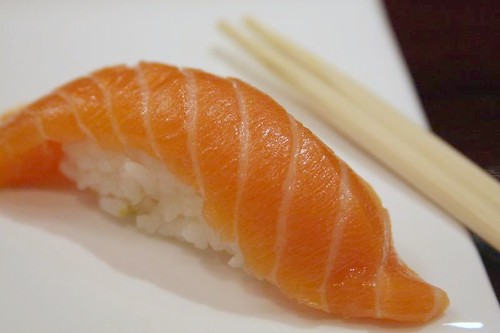Well, I'm here to please, so here goes.
One of my favorite kinds of Japanese food (although admittedly stereotypical) is sushi. But not just any sushi, dear readers. Oh, no. It's 回転寿司=kaitensushi.
Kaitensushi, or conveyor belt sushi, is the most magical thing in the world. Plates of sushi are carted around the restaurant on a moving belt. Each plate is its own tantalizing, delicious, or just plain unusual kind of sushi. You just take whatever you want, and then when you finish eating they count up your plates and tell you the damage. Each plate ranges around 105 to 200 yen- that's a little over one or two dollars each. Practically highway robbery. Mmmm, Delicious.
My favorite kinds of sushi include:
negi toro gunkan maki and tekka maki
and tekka maki 

So when I kaitensushi I tend to pick these guys a lot. But along with traditional favorites, there are many wacky kinds of sushi such as corn sushi or hot dog sushi. There are also weird and sometimes delicious deserts that come down the belt. When I got back from the States this winter, attempting to get out of my sushi rut, I declared that I was going to try a new dish I had never eaten before. Unfortunately that's when my friend stepped in. He chose one for me. In fact, he chose the grossest looking dessert on the belt.

<--- Taiyaki Jello. Taiyaki, the name of that fish looking thing swallowed by the whipped cream, is a pretty popular treat in Japan. It's actually a pancake type thing baked in the shape of a fish filled with adzuki bean paste. Now, even at the best of times, when the taiyaki is warm and fresh and golden brown: I'm not a fan.
This taiyaki, however, was kind of stale and very cold. The jello he was stuck in was the strangest flavor ever. Ian though it was kind of coconut-ty in an unpleasant way, but I thought it tasted like jellified cough medicine. Not to mention the thought of all the cow bones that went into the making of that jello . . . brrr. No thank you. But I did say I would try something new, so I persevered. Here is me not enjoying my dessert-------->
The jello he was stuck in was the strangest flavor ever. Ian though it was kind of coconut-ty in an unpleasant way, but I thought it tasted like jellified cough medicine. Not to mention the thought of all the cow bones that went into the making of that jello . . . brrr. No thank you. But I did say I would try something new, so I persevered. Here is me not enjoying my dessert-------->

I tried to give him a taste of his own medicine, but he would have none of it. "No Natalie! Eat all of your fish cake or you'll go to bed without any more sushi!" Jerk. On an interesting note, in Japan they call "jello" "zerry" which is kind of like their pronunciation of "jelly". And our concept of jelly is a mystery to them. They know jam, but not jelly. Isn't language interesting?

<--- Taiyaki Jello. Taiyaki, the name of that fish looking thing swallowed by the whipped cream, is a pretty popular treat in Japan. It's actually a pancake type thing baked in the shape of a fish filled with adzuki bean paste. Now, even at the best of times, when the taiyaki is warm and fresh and golden brown: I'm not a fan.
This taiyaki, however, was kind of stale and very cold.
 The jello he was stuck in was the strangest flavor ever. Ian though it was kind of coconut-ty in an unpleasant way, but I thought it tasted like jellified cough medicine. Not to mention the thought of all the cow bones that went into the making of that jello . . . brrr. No thank you. But I did say I would try something new, so I persevered. Here is me not enjoying my dessert-------->
The jello he was stuck in was the strangest flavor ever. Ian though it was kind of coconut-ty in an unpleasant way, but I thought it tasted like jellified cough medicine. Not to mention the thought of all the cow bones that went into the making of that jello . . . brrr. No thank you. But I did say I would try something new, so I persevered. Here is me not enjoying my dessert-------->
I tried to give him a taste of his own medicine, but he would have none of it. "No Natalie! Eat all of your fish cake or you'll go to bed without any more sushi!" Jerk. On an interesting note, in Japan they call "jello" "zerry" which is kind of like their pronunciation of "jelly". And our concept of jelly is a mystery to them. They know jam, but not jelly. Isn't language interesting?
I suppose I should have specified that I wanted to try something new and tasty, not new and gross. In the end all I was left with a half eaten fish cake and 105 yen for my troubles. I guess that's the way the sushi roulette rolls. 























